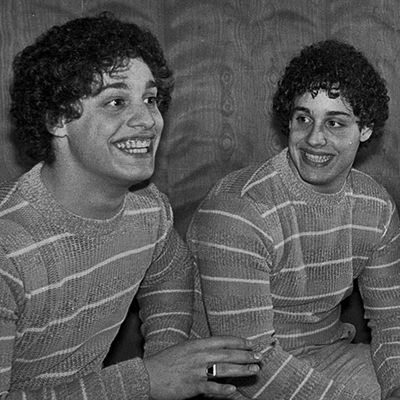
The knockout documentary Three Identical Strangers begins as a goofy, believe-it-or-not tabloid story and slowly drifts into darker waters — the realm of horror, then of tragedy. At first it sounds like The Parent Trap. Robert Shafran recounts how nearly 40 years ago, he showed up at college in upstate New York, where people he didn’t know said “Hi!” and embraced him. (There are reenactments, but they’re not tacky.) Not long after, the former roommate of one Eddy Galland drove Shafran all the way to Long Island, where Robert met his double. He and Eddy were born on the same day and adopted at six months from a “premiere” Jewish agency, Louise Wise Services. After their photo appeared in various New York tabs, another ringer — David Kellman — came forward. The trio were a media sensation, appearing with Phil Donahue, Jane Pauley, etc. How amazing it was that they had the same mannerisms and taste in women. Nature versus nurture? Score one for nature! They moved in together, did a bit in a movie, and opened a restaurant in Soho called Triplets Roumanian Steak House.
The director, Tim Wardle, has shaped the film as a detective story in which the more pieces of the puzzle are filled in, the more disgusted and infuriated we become. Without revealing too much, I’ll say the path leads beyond Louise Wise to a Strangelove-ian Austrian Holocaust refugee and a secret study that’s in one respect tantalizing and, in all the ways that matter, diabolical. The New Yorker’s Lawrence Wright, who learned what he could before publishing an article, helps frame the story, but it’s the brothers’ misery, their existential anguish, that holds us spellbound. Was it coincidence that one was raised working class, one middle class, and one upper middle class, and that each coped with deep depression in vastly different ways? Suddenly, nurture makes a comeback, big time.
Perhaps the most troubling part of Three Identical Strangers is that while we dream of secret files’ being liberated from Yale, where they’re locked away until 2065, and of those still living and obfuscating being roasted on spits, we drink in the details. Three human beings — and possibly many more — were damaged beyond repair, but that damage is done. Scientifically speaking, we might as well learn from the study. Am I right? Am I? Anyone?
*This article appears in the June 25, 2018, issue of New York Magazine. Subscribe Now!


